With summer approaching, it's the best time to make use of the fine weather and enjoy your favourite outdoor activities. It could be something simple like going for a bike ride or using the outdoor gym at your local park. If you’re in the mood to plan something, you could plan a camping trip or a hike in some of the best spots around the country. If you are looking to take to the water this summer, then activities like rafting, kayaking or boating might take your fancy. However, if you are on the lookout for a water activity that will also contribute to keeping fit then paddleboarding might be the perfect sport to master this season.
What is paddleboarding?
Paddleboarding is a water sport that involves standing, kneeling or sitting on a paddle board and gliding across a water body using a paddle to push forward and steer. The most well-known form is commonly known as Stand-Up Paddleboarding or SUP which has been gaining a lot of popularity over the past few years worldwide. This water activity that involves standing up and paddling across rivers or lakes has caught the fancy of fitness geeks, adventure lovers and families alike owing to how versatile it is. There’s definitely something for everyone when it comes to paddleboarding.
Nigel Muir, chief instructor at Paddle Richmond which is a London-based paddleboarding club says, “Paddleboarding comes with loads of benefits, from improving your fitness and balance, having a really positive impact on your mental well-being, and connecting you with nature.”
“It’s a sport that’s open to all ages and all fitness levels, and is relatively easy to learn, with fast progression from beginner to master. It’s also really fun,” he adds.
As an activity that can easily be picked up and pursued with minimal gear, paddleboarding is definitely an affordable sport. There are easy moves and techniques that can be picked up by kids as well, making it a perfect way to spend a sunny day out on the water as a family. With numerous paddleboarding clubs and organisations, this is also a fun way to meet new people and expand your circle while also mastering a new sport.
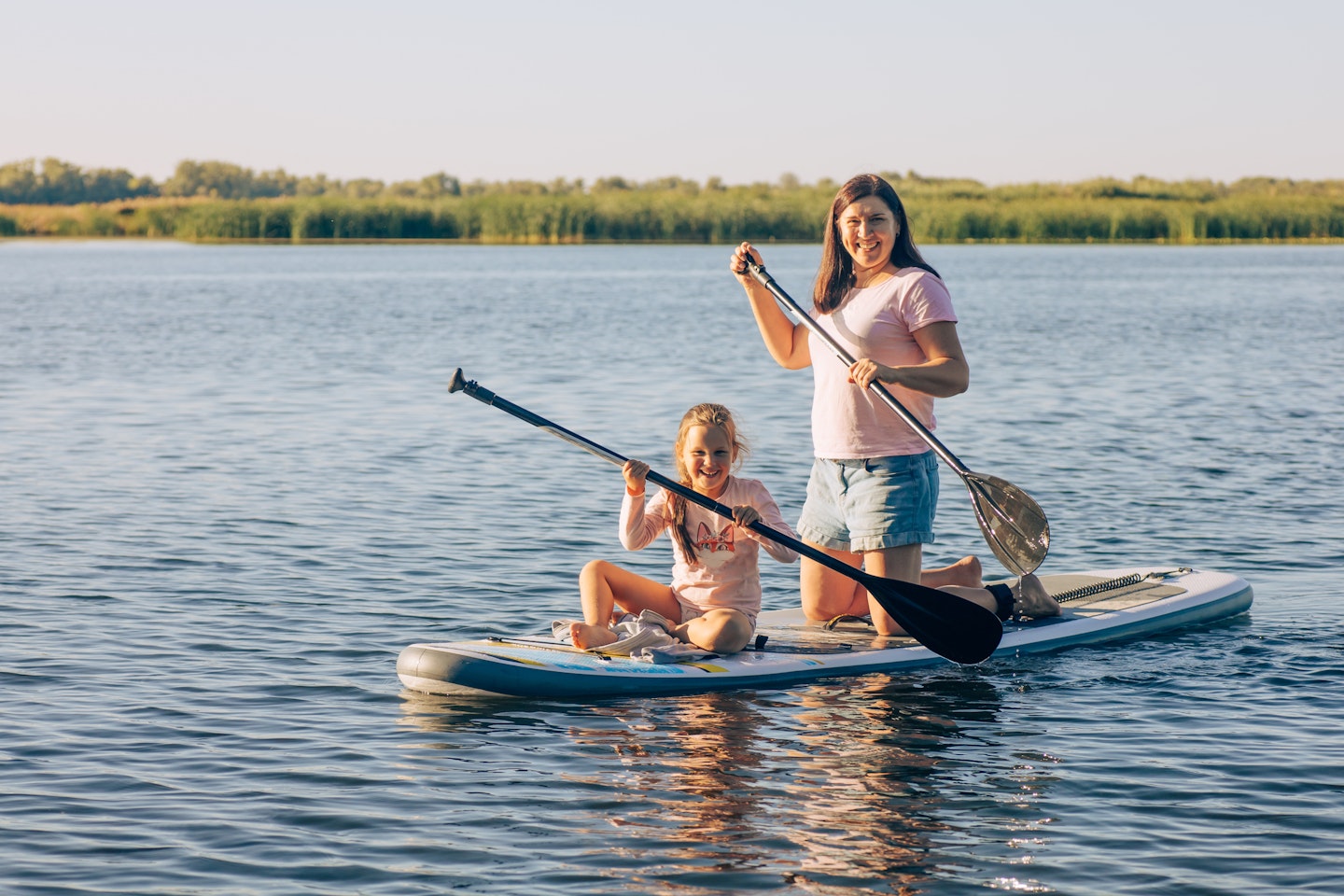
An example of how paddleboarding can help you connect to bigger circles and purposes is the Big Paddle Cleanup 2024 which is taking place again after last year’s success had over 2600 paddlers taking part and cleaning local water bodies by removing plastic, glass, cans and trash as part of raising awareness to reduce water pollution. It is something you can volunteer to do, record it with the larger team and share it on socials to spread the message.
Benefits of paddleboarding
From a fitness point of view, paddleboarding comes with a host of health benefits. With beginner-level paddle strokes and balancing tips, kids can enjoy this activity while cultivating an active outdoor lifestyle. As a physical activity that is not very strenuous or intense, paddleboarding is also good for older people to enjoy getting fit with a fun activity.
Paddleboarding expert Nigel Muir explains how the sport gives you a full body workout, as you use all the major muscle groups when you’re paddling. “It improves your strength, coordination and balance, as well as your cardiovascular health. It’s also really low impact on joints, unlike running for example,” he adds.
1. Paddleboarding as a core workout
There are several reasons to take up paddleboarding as a full-body workout, with a special focus on your core. The upright position combined with the paddling to stay balanced on the board requires you to control and exert your core. The workout comes from trying to remain balanced and the rockier the water, the more you will be able to put your core to work. This will help to strengthen your core abdominal muscles and provide a similar workout as when you do planks or crunches.
2. Paddleboarding for upper body workout
The act of rhythmic paddling provides an immense workout to your arms, shoulders and back muscles. Continuing paddling by taking short breaks in between to chat or take in the scenery can act as reps while you are building your strength and toning your upper body at the same time. This would be much more interesting than sweating it out on the shoulder presses and cross trainers at the gym this summer.
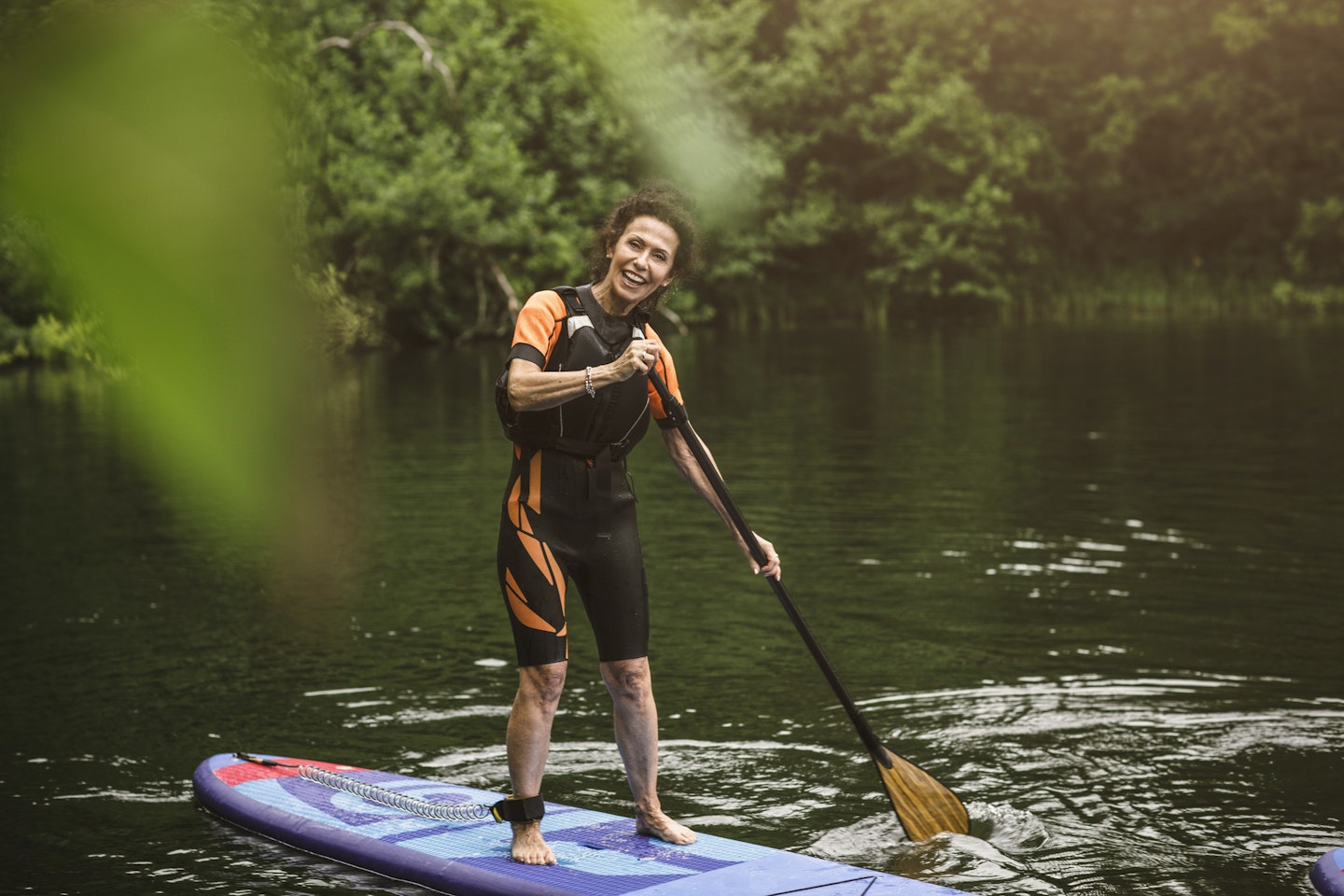
3. Legs, bums and tums with paddleboarding
Paddleboarding serves as a lower body workout as well. Standing up and paddling will have you stretching, warming up and applying pressure on your quads, hamstrings, and calves to workout these muscles. This will burn fat, tone your leg muscles and build strength much like what your squats, bridges and calf raises do.
4. Paddleboarding for heart health
Experts have stated that paddleboarding improves your cardiovascular health, maintains blood pressure and lipid profiles when taken up regularly. The consistent movement with paddling provides the perfect cardiovascular workout by maintaining a high heart rate. As a physical activity that is not too strenuous or hard on the joints, it is a great way to take care of your heart health at all ages.
5. Paddleboarding for weight loss
Offering a full-body workout that hits all the core muscles in your upper body, abdomen and legs, paddleboarding can help with weight loss. Dedicating to a regular routine of paddleboarding that combines reps of fast and relaxed paddling with sessions of warm-ups beforehand can help you see visible results.
6. SUP yoga
Stand Up Paddleboard (SUP) Yoga is a combination of paddleboarding and yoga which originated in Hawaii has taken the fitness world by storm because of how easy, risk-free, and beneficial it is. It involves practising yoga, but outdoors on a paddleboard floating on the water. The merits of the ancient Indian form of meditation coupled with the balance and core strength required to maintain the positions and controlled breathing on the water surface amplifies the health benefits of SUP yoga.

7. Paddleboarding for mental wellbeing
As an activity that allows you to be outdoors, physically engaged in rhythmic motions and concentrate on workouts if you are incorporating those into your paddling sessions, this sport can leave you feeling very relaxed and refreshed after. Paddleboarding can help reduce stress, get into a meditative state of mind, find like-minded community and the enjoy nature at the same time.
“It is proven that humans love water, and need to be near blue spaces. Once you’re out on the water, you can’t help but feel happier. Paddleboarding gets people out on river, lakes and the sea, and lets them discover new places, see their area from a new perspective and get close to nature and wildlife,” adds Muir.
Paddleboarding for beginners
Learning how to paddleboard can be easy and fun with the right techniques, instructions and group. There are several paddleboarding spots and groups where you can be a part of a community and learn. But if you wish to pick up the basics and then master it on your own time, there are helpful tips and safety hacks to keep in mind.
As a certified paddleboarding instructor at Paddle Richmond, Muir shares that it is important to start with lessons at an approved paddleboarding school.
“You may be able to pick up the sport without a lesson as well with a qualified instructor who can get you standing up quickly. But you need to make sure you have the right technique to paddle properly without tiring yourself out and risking injury.”
“The important thing is to stay on your knees until you are in deeper water and away from any obstructions. Paddling on your knees is very stable, and that’s how you should always start your paddle session. Don’t try to be ‘cool’ by standing from the start, and then fall or hurt yourself,” he advises.
“Lessons help because they will also teach you about safety, and give you plenty of tips on how to avoid danger on the water,” he adds.
Emphasising that safety is key for new paddleboarders he listed out things that beginners should always be mindful of.
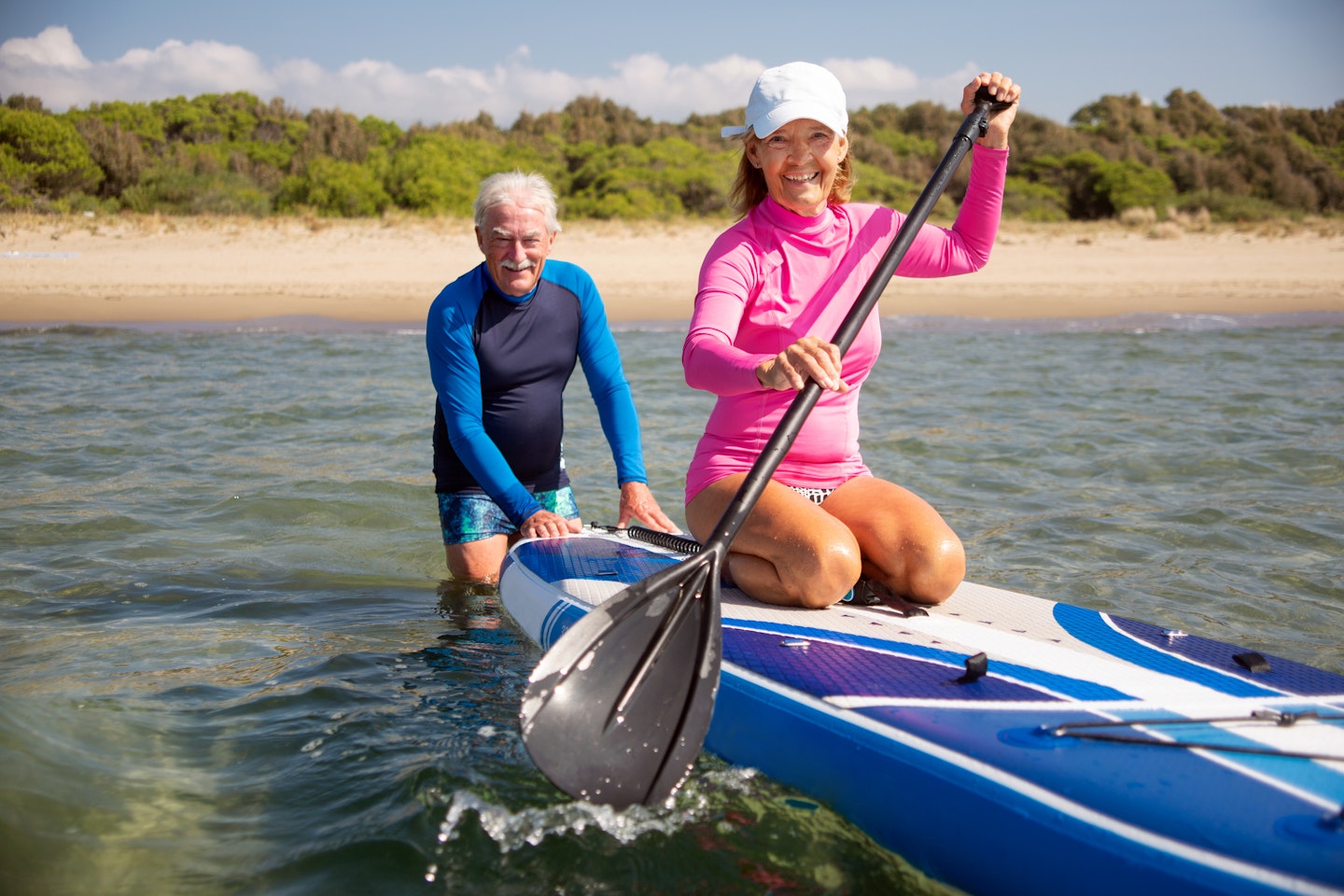
Paddleboarding tips from an expert
-
Always wear a buoyancy aid as the water in the UK is cold, even in summer
-
Incorporate the correct type of leash for your environment (a quick release waist belt attached to a leash for rivers or moving water, or an ankle leash for the sea or lakes).
-
Carry a means of communication – usually a phone in a waterproof case. Call 999 and ask for the Coastguard if you are in trouble.
-
Paddle with someone else or a group for safety
-
Tell someone where you are going and when you expect to be back
-
Watch out for offshore winds which can blow you away from a beach
-
Be aware of moored boats, jetties, pontoons and other obstructions and keep well away, particularly in moving water like a river.
-
It will help to talk to someone with experience before you try it out yourself.
Learn how to fall
Muir explains that the risks involved in falling are that you could hit rocks on the bottom, or hurt yourself on hard objects near your launch point. “Once you’re in deeper water, it’s safe to stand, and if you fall you won’t hit anything. Always try to fall flat, rather than tombstone deep into the water,” he says.
“If you are wearing a buoyancy aid, which ideally you should be, you will float and can easily swim to recover your board. Your leash will keep your board close to you. Your instructor will definitely teach you how to self-rescue by climbing back on your board,” he adds.
How to choose the right sized paddle board?
“The right size board will depend on where you want to paddle, your weight and height, the number of different people who may use the board, your experience and your budget,” says Muir.
-
All-round board is good for different paddlers, and different locations. It is round nosed and quite wide. Typical dimensions are 10’6 long and about 32” wide. They are great for beginners, and messing around on the sea or lake, but quite slow in the water.
-
Touring boards are longer, typically 11’6 to 14’ and glide better than all-round boards. They are quicker through the water and allow you to explore further afield. The length doesn’t affect the stability, but the width does. A 32” to 34” wide board will be very stable, whereas 28” to 30” wide board will be more tippy, but faster.
-
Race boards are longer and narrower, typically 12’6 to 14’ long, and 24” to 28” wide. They are fast but not very stable for a beginner.
“My advice would be to try different boards out before you buy. Paddleboard schools often offer demo sessions where you can try different boards and paddles.”
“Most people think they will need a 10”6 board and often quickly outgrow it, and move on to a touring board. As progression in the sport is so quick, it’s probably worth investing in an intermediate board, rather than getting a beginner one and then wanting to change it,” he adds.
Best paddleboards
Best paddleboard for beginners
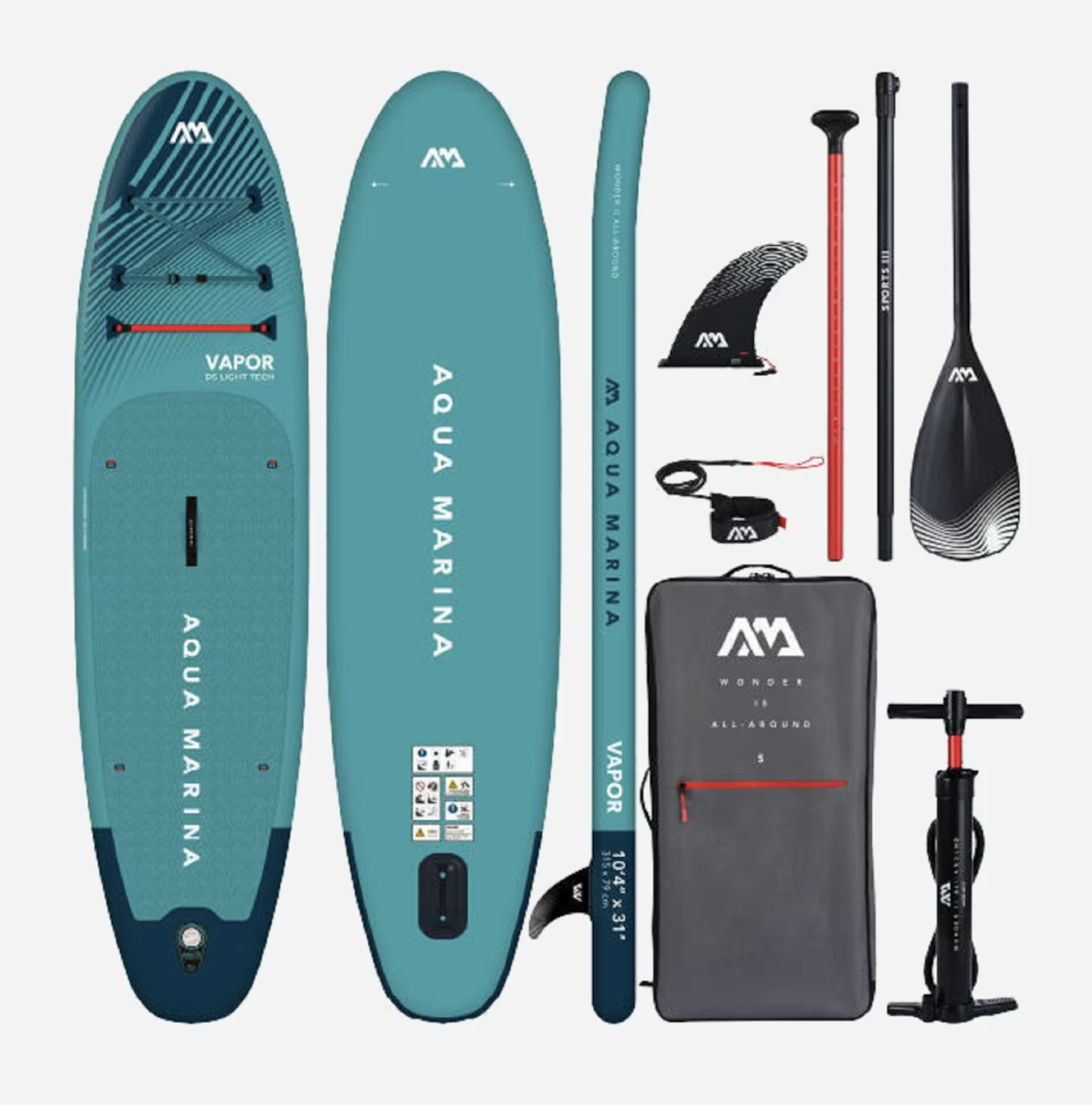
www.decathlon.co.uk
The Aqua Marina Vapor stand-up paddle board package is perfect for those who are looking to try out paddleboarding as beginners. It helps that you get the whole package including the SUP board, a stainless steel safety leash and paddle along with a zip backpack that you can fit all the equipment into to transport and store the kit easily. With improved stability and a diamond grooving footpad that provides extra grip, this board suits the requirements of beginners. The board is also lightweight and super stiff making it easy to master paddleboarding while starting out.
Pros
- Lightweight and comes with improved stability and grip making it esay for beginners
- Comes with a backpack which makes transport and storage easy
Cons
- Does not come with a seat
| Size: | Length - 10'4""/315cm <br>Width - 31""/79cm <br>Thickness - 6""/15cm |
| Maximum weight capacity: | 140kg |
Best value paddleboard for beginners
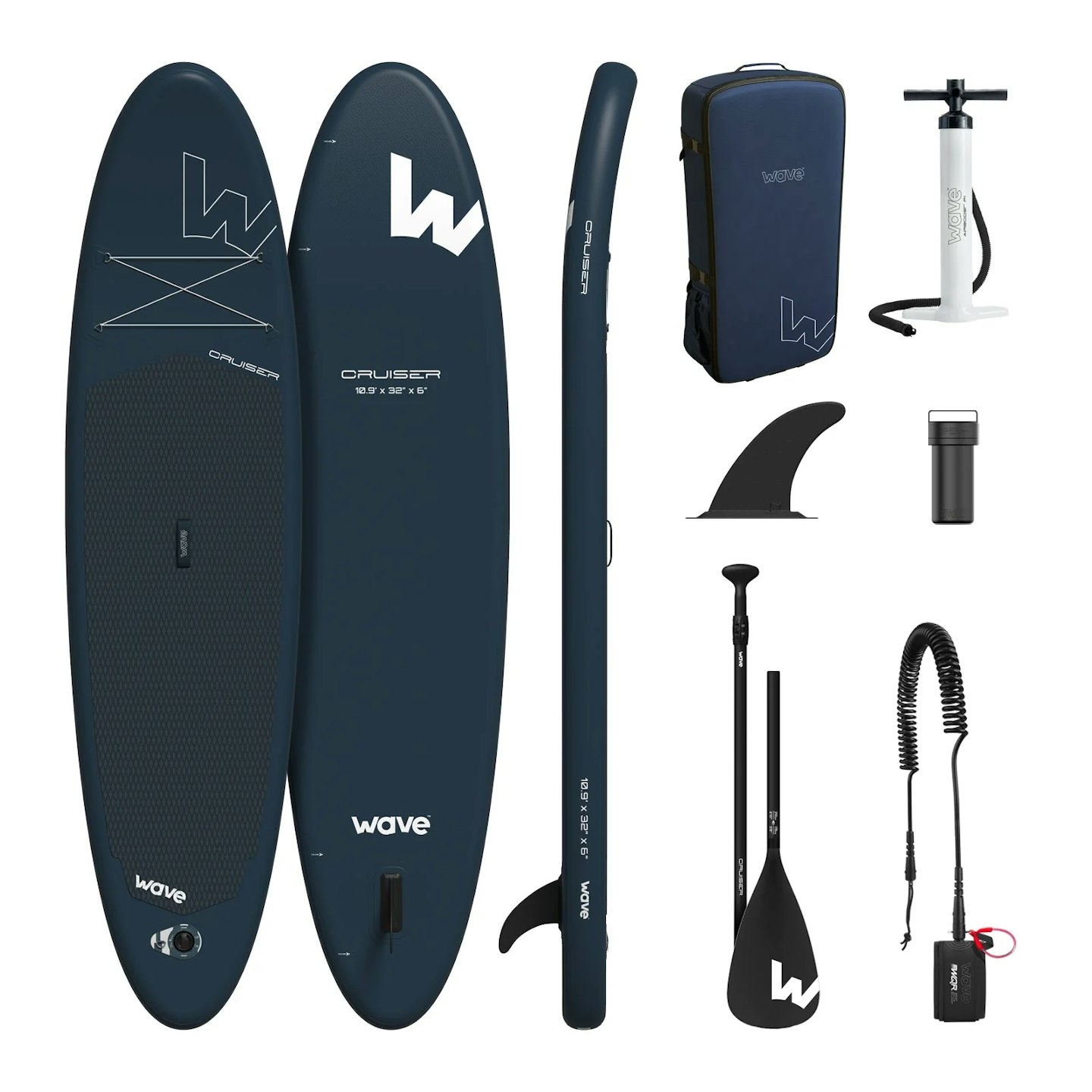
wavesupboards.com
If you are on the lookout for a value paddleboard that also comes with all the equipment you need to get out on the water, then the Cruiser 2.0 Inflatable Paddleboard is the perfect choice for you. The set comes with a paddle, quick-release ankle leash, quick slide fin, single action pump to inflate the board and a backpack to hold and move all the equipment. The instruction manual would also be helpful if getting started. The grooved foam design provides extra grip and the board is made of Military Grade PVC Material which also makes it quite tough and durable. The design and build of the board is also quite beginner friendly.
Pros
- The board comes with a quick-slide fin which improves stability making it better for beginners
- The set includes a backpack which makes transport and storage easier
Cons
- The board does not come with a seat
| Size: | 327x81x15cm | 10'9x32x6" |
| Maximum weight capacity: | 130kg |
Best paddleboard for heavier riders
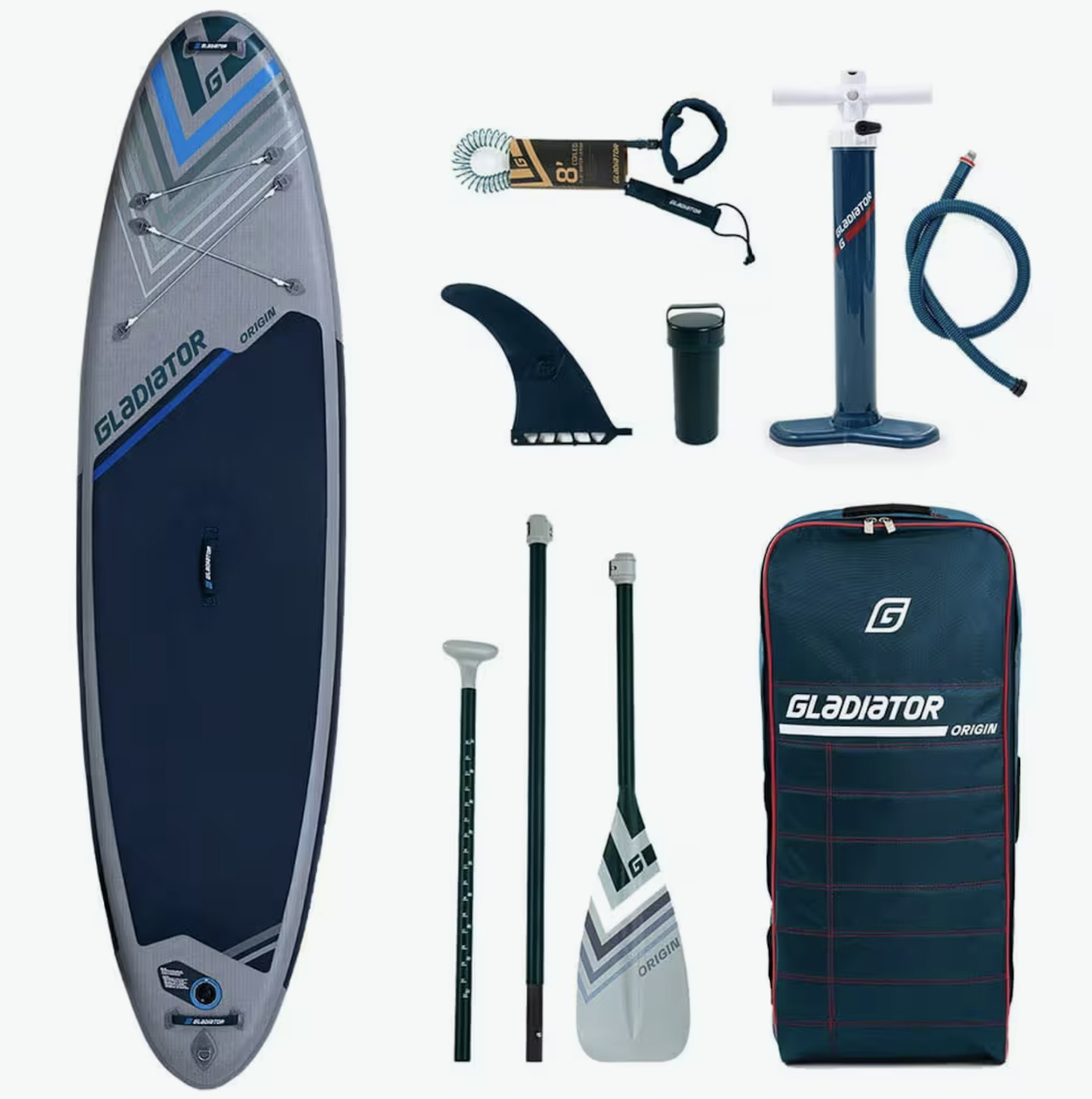
www.decathlon.co.uk
The Gladiator Origin All Round Paddleboard with a width of 34" and thickness of 5.9", is well suited for riders over 85 kgs. The board also comes with features like the front, rear, and centre carrying handles that helps in easy transportation and bungee tie-downs for carrying. The fibreglass shaft combined with a nylon blade makes it very light and durable that would be easy for beginners to get accustomed to. The kit also comes with a coiled leash, a universal fin and a maintenance kit along with a backpack to hold it all together. The board provides extra stability that makes it easy for people of all experience levels to use the board.
Pros
- Suitable for heavier riders
- Comes with a fin that provides extra stability making it suitable for beginners as well
Cons
- Falls in a higher price range
| Size: | 10’8 x 34” x 5.9" |
| Maximum weight capacity: | 200 kg |
Best paddleboard for long-distance paddling
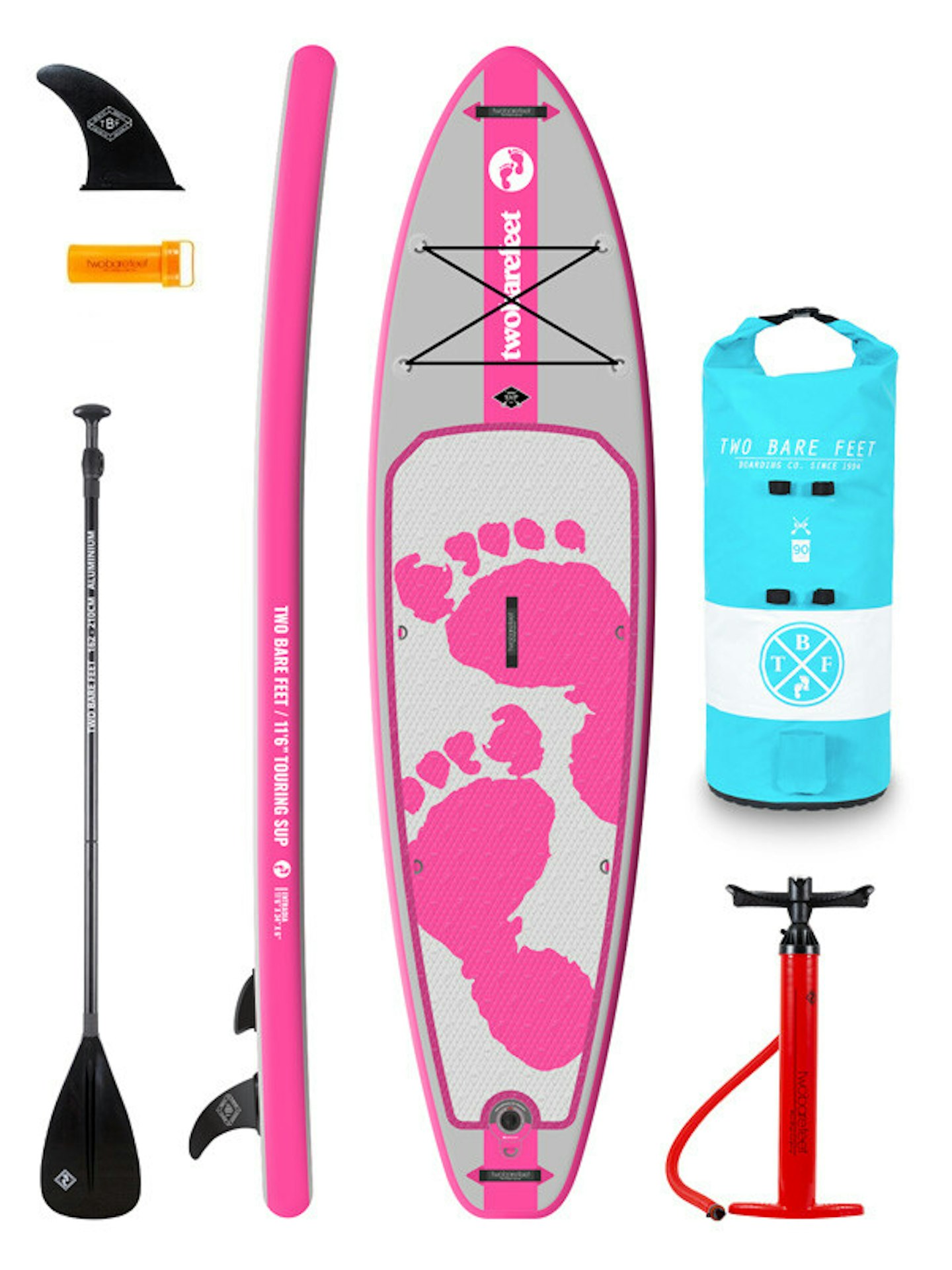
www.twobarefeet.co.uk
If you are a more experienced person who is looking for a quality paddleboard that is suitable for distance paddling, the Two Bare Feet Entradia Touring Paddleboard is a good option to consider. This board is perfect for beginners and intermediate users alike. What makes it different from the basic boards is that it is slightly smaller in order to remain more agile which helps in long-distance paddling. With a 6” thickness and 34” width, the board is also very stable and perfect for use on oceans, rivers, canals or large lakes. As a kit, it also packs a paddle, fin, pump and a backpack as well.
Pros
- Comes as a complete kit that is suitable for beginners and intermediate users alike
Cons
- Falls in a higher price range
| Size: | 11'6" x 34" x 6" |
| Maximum weight capacity: | 220kg |
Best paddleboard with seat
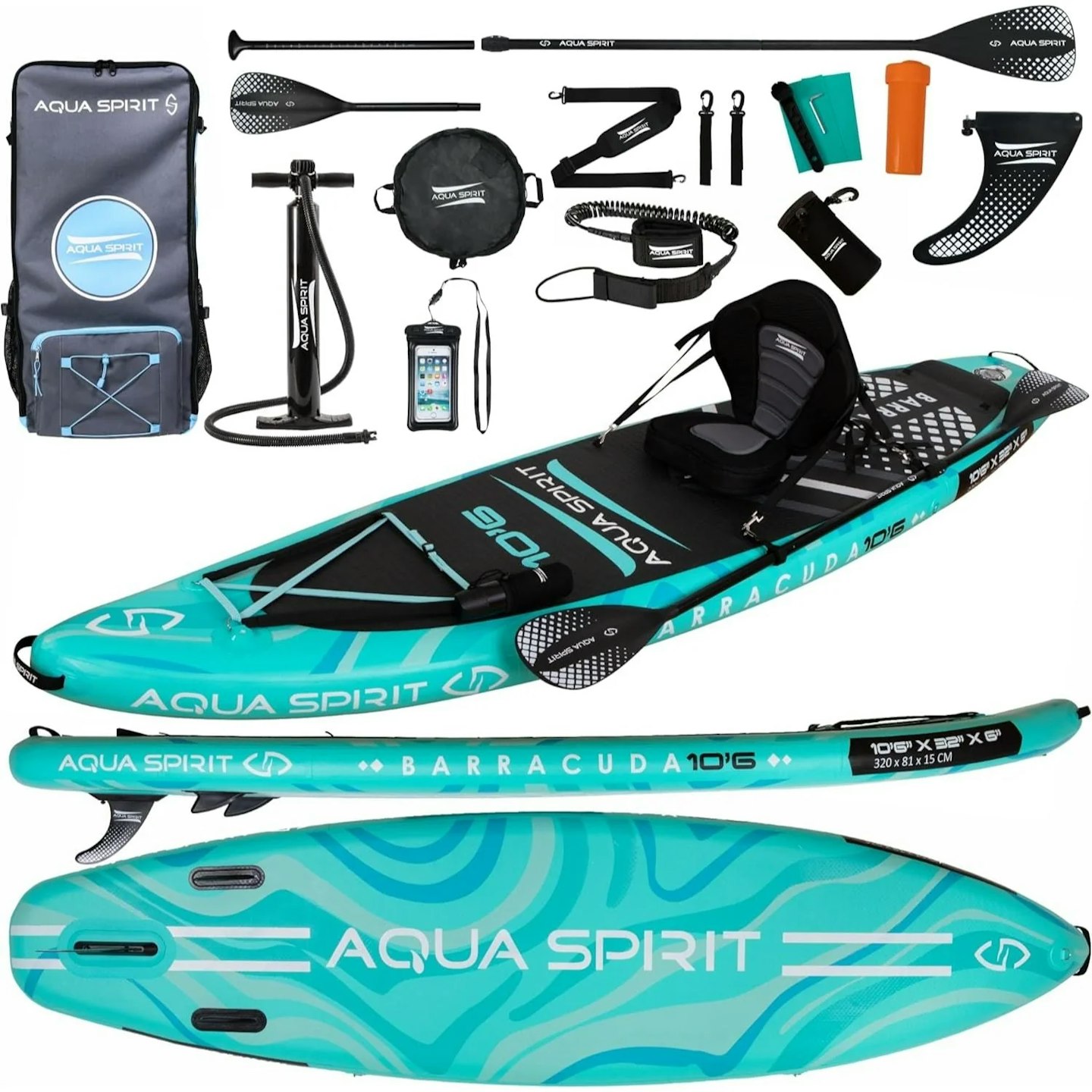
aquaspiritisup.com
If you are looking for a paddleboard that is perfect for spending a long time relaxing on the water, then this Aqua Spirit Barracuda Paddle Board which comes with a seat is a good choice. What sets this board apart is that it can function as a premium stand up paddleboard and kayak with features that offer the high performance of touring boards, along with comfort and stability of all-round leisure boards. As a kit, it also comes with a leash, go-pro mount, changing mat, pump, waterproof phone case and a backpack. The versatile sleek build which also comes with enhanced stability makes it suitable for beginners and experts alike. The board also comes with a kayak seat with extra cushion coupled with an extra blade to offer a double-sided kayak paddle if needed. This set-up perfect if you need a break from standing or if you are setting out for long durations on the water. If a board that combines performance and leisure is what you are after, then this could be the perfect option for you.
Pros
- Comes with a kayak seat and the paddle can be transformed into a double-sided one if needed
- The board is built to suit the needs of beginners and experts alike
Cons
- Some users found that the pump was not as good as expected
- Some reviews also state that the paddle handle does not lock in place tightly enough
| Size: | 10ft 6 x 31" x 6" / 320 x 79 x 15cm |
| Maximum weight capacity: | 150kg |
Best paddleboard for families or groups
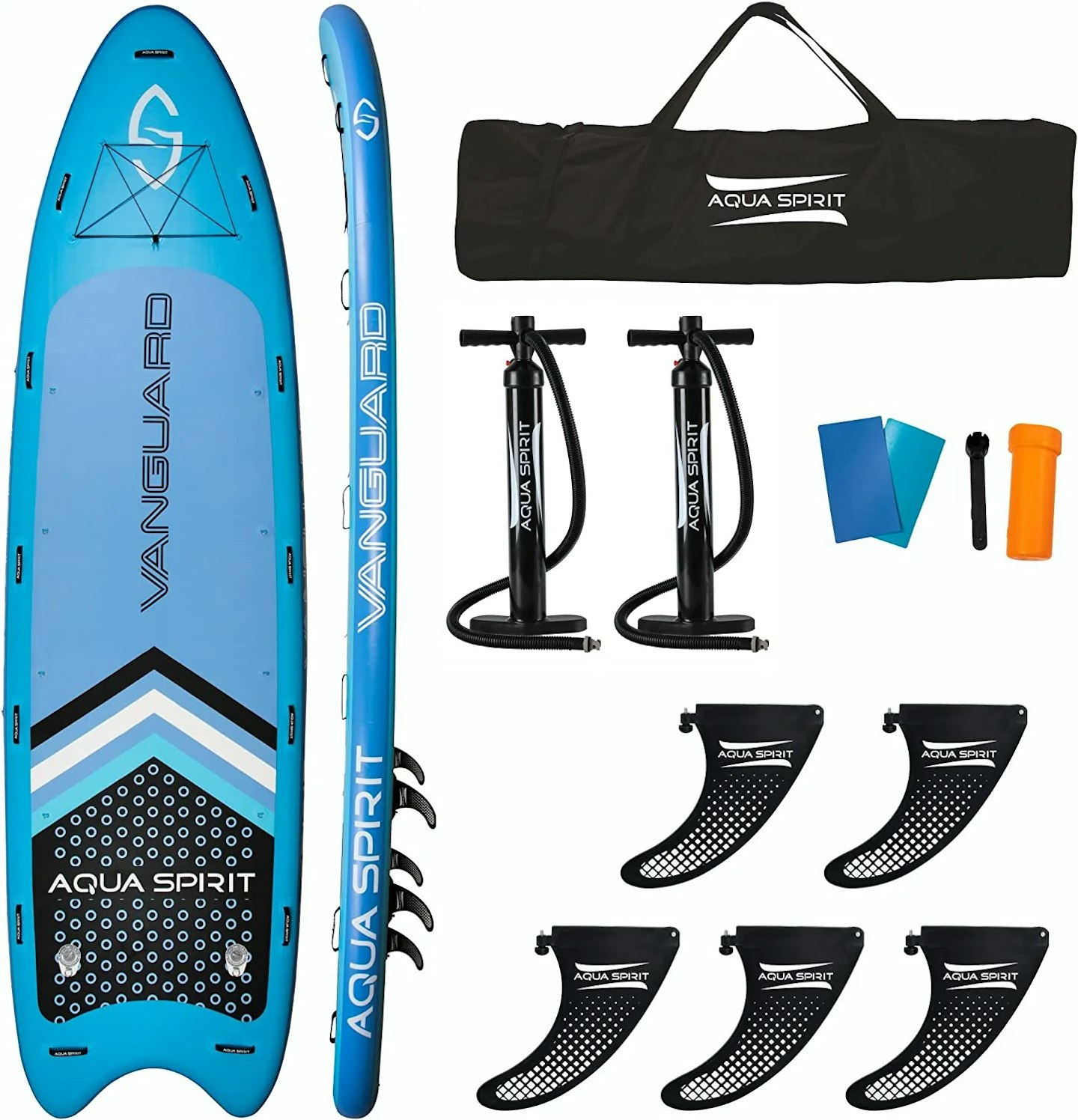
aquaspiritisup.com
If your idea of fun is spending a relaxed day out on the water with your family or a group of friends, then this Aqua Spirit Vanguard Family Paddleboard that is fit for multi-person use will be the perfect choice for you. With dimensions of 18ft x 5’ x 8" / 550 x 153 x 20cm and a rider weight capacity of 500kg, this paddleboard is built to be enjoyed by a group of up to 8 people. The board is also perfect to be used by families with children who want to paddle or sit on the board. The kit includes a carry bag, 2 hand pumps, 5 centre fins, and repair kit. The build of the board provides the support and stability of an all-round leisure board while also offering the performance of a touring board. With the nose of the board narrowing into a raised tip, it helps to rapidly move through still or choppy water. So, if you fancy days out on the water as a group with family or friends, then this is the paddleboard to go for.
Pros
- The kit comes with 2 hand pumps for easy inflation
- With 5 centre fins, the board provides extra stability for beginners and children
Cons
- Paddles need to be purchased separately
| Size: | 18ft x 5’ x 8" / 550 x 153 x 20cm |
| Maximum weight capacity: | 500kg |
Best paddleboard for experts
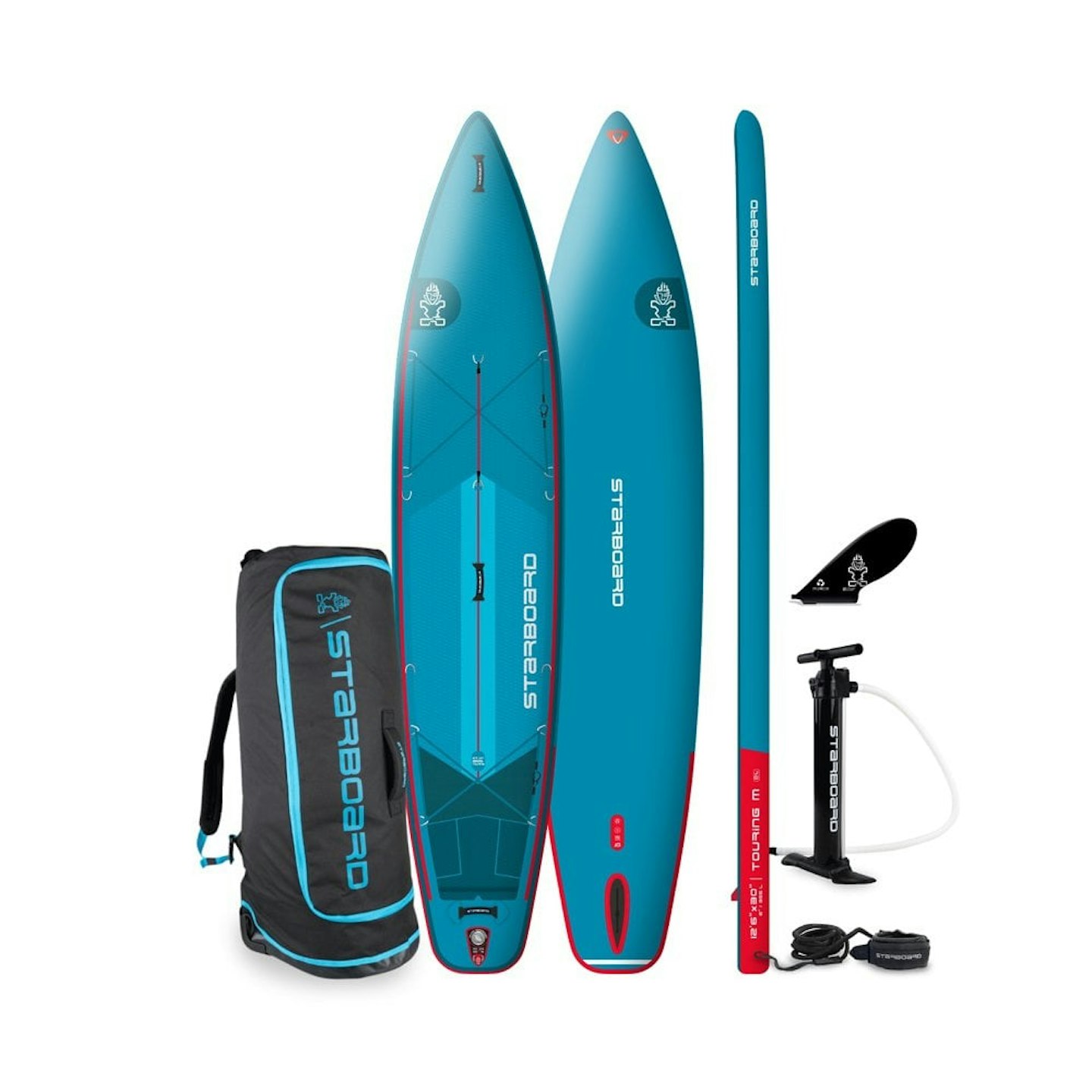
www.thesupco.com
The Starboard Deluxe Lite Touring Board is the perfect choice for more expert users as the board comes with straight outlines and a narrower design which provides more glide and agility. You can pursue higher speeds and distances with this board and with a 30" width, it provides more stability than most touring boards. The board is also built to carry loads of equipment if you are interested in longer explorations and the design makes it quite rigid and light weight as well. As a kit that also comes with a pump, leash and a backpack, this is a good option to consider for seasoned paddle boarders.
Pros
- The narrow design allows more glide and agility
- With more width, the board is more stable than most touring boards
Cons
- The pack does not come with a paddle
| Size: | 12'6" feet / 381 cm<br>30" inches / 76.2 cm<br>6" inches / 15.2 cm |
| Maximum weight capacity: | 55 - 110kg |
FAQs
What to wear while paddle boarding?
“In the British summer we recommend wearing a running kit or a swim suit. Clothing needs to be quick drying and wicking, so ideally not cotton, and definitely not jeans. Take an extra layer like a fleece and a waterproof jacket in a dry bag in case you get cold or the weather changes,” says Muir.
“In colder months, or when paddling on the sea, wear a wetsuit. This will keep you warm if you fall in, although in summer you can get very hot paddling in a wetsuit. In winter many paddlers wear a dry suit, over lots of warm layers.”
He also suggests that a hat will keep the sun off you in summer, and keep you warm in winter along with polarised sunglasses that come with straps to reduce the glare and protect your eyes.
While lots of people paddle barefoot, if the water is rocky or cold you may want to wear water shoes, wetsuit booties, old trainers or even flip flops according to him.
How much does a good paddle board cost?
Paddleboards are available in price ranges that go from £200 for a basic board to £2000 plus for a top race board. While £200-£400 will get you a basic all-rounder paddleboard, which won’t be the highest quality and may not be as durable as more expensive ones, it is quite enough to get you started if you go for ones from known brand such as Decathlon, Fanatic, Two Bare Feet according to Muir.
Muir goes on to explain that the midrange ones are priced between £400-£600 and opens up the touring boards to you which are stiffer, better built and should come with a lighter and stiffer paddle. With £600-£1000 you can get a premium quality board that will be lighter, with far stronger construction and hold its shape really well.
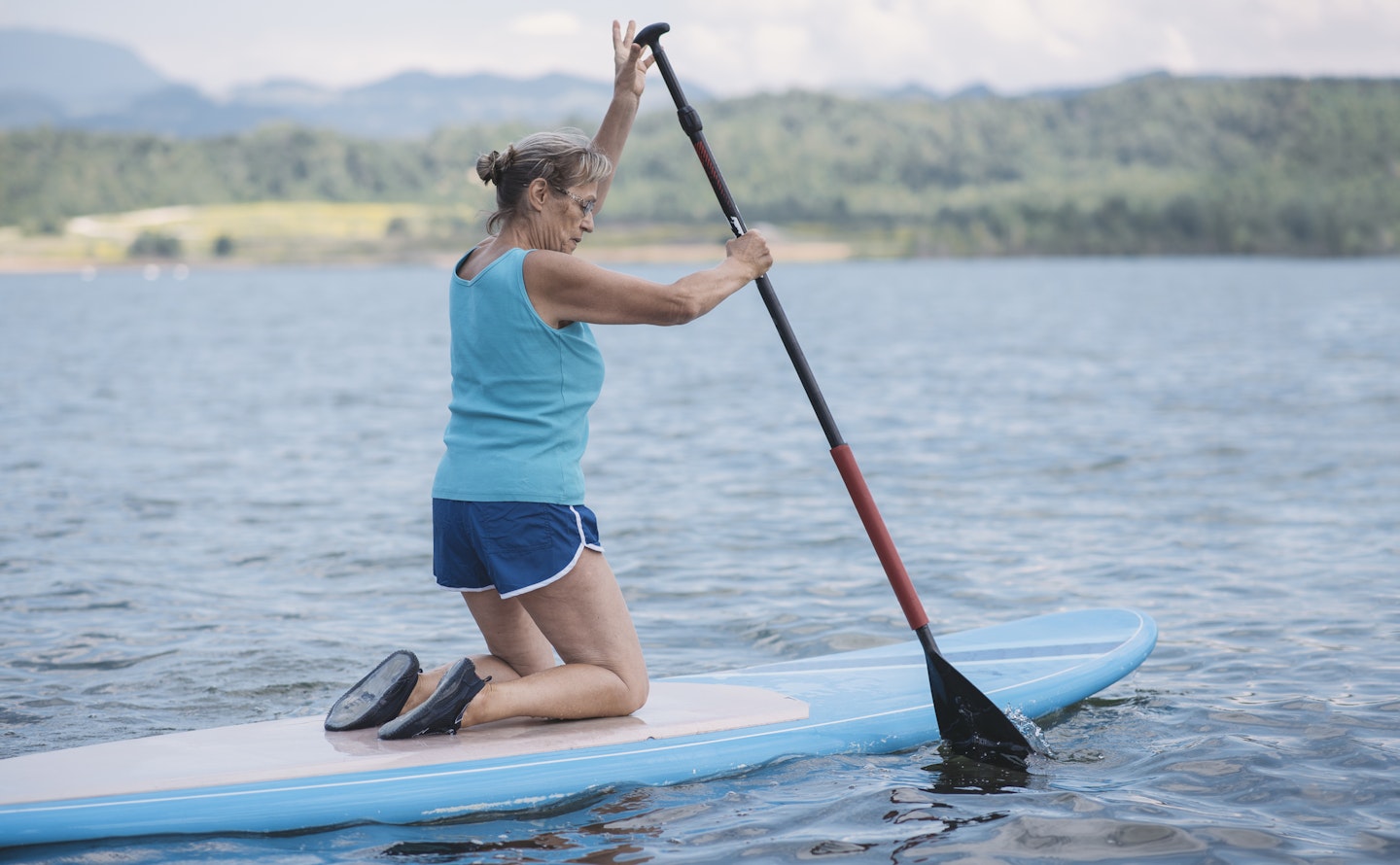
Meet the expert
Nigel Muir is the chief instructor at Paddle Richmond which is a London-based paddleboarding club. He is a qualified SUP Adventure Guide and a certified SUP Search and Rescue Technician.
Akhila Thomas is a digital writer at Yours.co.uk. She has previously written for magazines like Leftlion, Women’s Health and t’Art and worked extensively with art, culture, fashion and social media trends. She loves writing about beauty, fashion, food, wellness and lifestyle. She also likes to travel and explore new cultures and cuisines.
